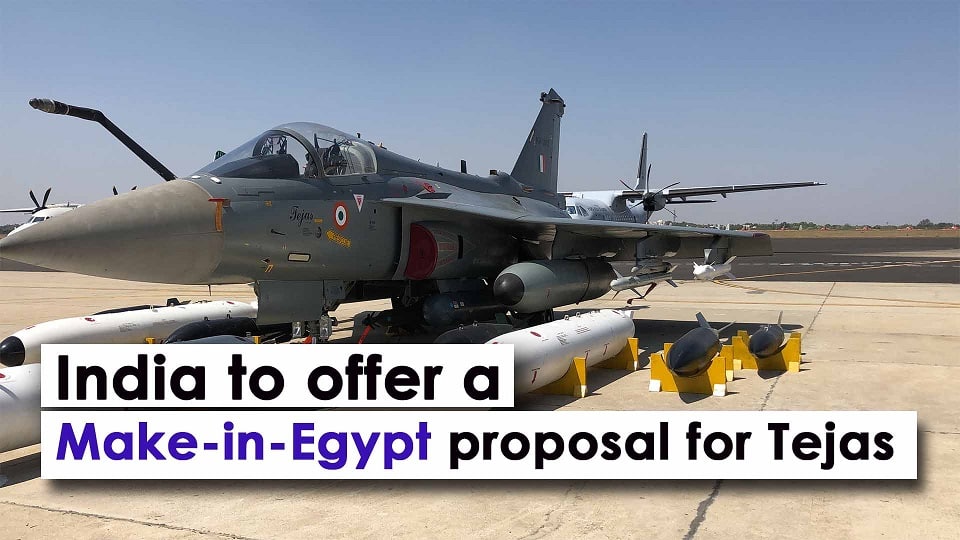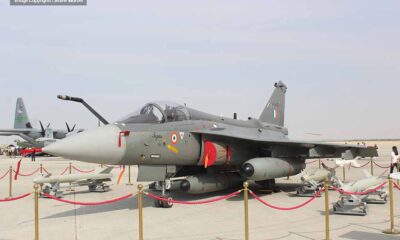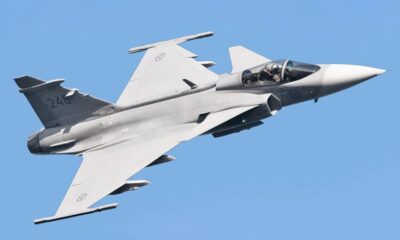Aerospace
India to offer a make-in-Egypt proposal for 70 Tejas planes?

The Indian Tejas is roaring high in capacity and power, and now HAL is attempting to offer a Tejas fighter aircraft deal to Egypt. It also intends to establish production facilities in Egypt for the manufacture of light combat aircraft (LCA) and helicopters as it seeks export prospects in the Middle East and North Africa region. Egypt is looking for a fleet of 70 aircraft in the LIFT category.
According to reports, the Egyptian Air Force head is scheduled to visit India in the coming days to inspect manufacturing and maintenance facilities.
Egypt is primarily interested in being the first to market with a fighter training aircraft variant based on the Tejas trainer airframe. The airframe will be stripped of high-end sensors and avionics but will incorporate training-specific cockpit equipment like as a Wide Area Display (WAD) to be utilized as an Advance Jet Trainer for inexperienced pilots before they move to Squadrons. The LIFT category aircraft assists pilots in becoming qualified before flying other fighters such as the Sukhoi 30 MKI, Rafale, or F16 fighter aircraft. The LIFT category aircraft is used for both training and combat purposes.
It boasts the most powerful air force fleet among emerging countries. Egypt’s air force has a mixed fleet of aircraft from China, Russia, the United States, and Europe, and it has recently placed orders for French Rafael fighters and Russian 35 fighters. It currently has approximately 220 f 16 fighters, 24 rafale, 15 mriage, and 46 mig 29 fighters.
HAL has the option of pushing the HTT 40 Hindustan Turbo Trainer aircraft, although this is still in the works. However, it will be advantageous to obtain a starting level trainer aircraft. HAL is contemplating an initial programme similar to the US Air Force’s T-X programme for a new-generation trainer aircraft produced by the SAAB-Boeing collaboration.
HAL is working hard to increase the number of export orders for TEJAS, and it confidently displayed the aircraft flying display in the Dubai and Singapore airshows. The aircraft is built on a sturdy airframe that has undergone extensive testing and has good avionics support. Tejas is now being upgraded to the Mark2 level for the Indian Air Force, which includes the latest avionics and weapon deployment capabilities.
The Royal Malaysian Air Force (RMAF) is the most promising potential customer, having bid for 18 light fighters with an option for another 18. This would be a welcome first export order for the Tejas.
HAL has provided the RMAF with the advanced Tejas Mark 1A fighter, which includes mid-air refueling, an AESA radar, electronic warfare (EW) capability, and the capacity to shoot BVR missiles. HAL is undergoing testing for the Malaysian-specified on-board oxygen generating system (OBOGS).
There is a considerable possibility that Tejas will outperform the other fighter capabilities and win the contract from Malaysia, but its government purchasing agency has yet to make a decision.

Aerospace
Which is bigger 777x or 787 aircraft ?

The 777X is a new series of the Boeing 777 family and is designed to be larger and more efficient than its predecessor. It features two variants: the 777-8 and the 777-9, being the larger of the two.
The Boeing 777X emerges as the larger sibling within the Boeing family, representing a significant leap forward in both size and efficiency. Comprising two variants, the 777-8 and the 777-9, the latter takes the crown as the larger of the two. With its expansive fuselage and impressive wingspan, the 777X is tailored for long-range journeys and boasts a substantial passenger capacity.
On the other hand, the Boeing 787, affectionately known as the Dreamliner, occupies a niche in the market as a smaller yet formidable aircraft designed for medium to long-range flights. Its distinguishing feature lies in its composite fuselage, a technological marvel that renders it lighter and more fuel-efficient compared to conventional aluminum counterparts. The Boeing 777X is larger than the Boeing 787 aircraft.
When it comes to passenger capacity, the 777-9 reigns supreme, typically accommodating a sizeable contingent of 400-425 passengers in its standard configuration. In contrast, the 787, with its more modest dimensions, typically carries between 240-290 passengers, depending on the variant and layout.
One of the remarkable innovations introduced with the 777X is its folding wingtips, a feature designed to address the logistical challenges of accommodating such a large aircraft in conventional airport gates. These folding wingtips enable the 777X to retract its wings, allowing it to fit into gates designed for smaller aircraft while still reaping the benefits of an extended wingspan during flight, thereby enhancing fuel efficiency and operational flexibility
Aerospace
China Secures Production Certificate for Mass Production of Pilotless eVTOL Aircraft

The first passenger-carrying pilotless electric vertical takeoff and landing (eVTOL) aircraft in the world, the EH216-S, has received the Production Certificate for its eVTOL aircraft from the Civil Aviation Administration of China (CAAC).
This is a significant milestone for EHang Holdings Limited, the leading UAM technology platform company in the world. This outstanding accomplishment is another big step towards mass manufacturing for the eVTOL aircraft and the ensuing commercial operations, building on the ground-breaking acquisition of the Type Certificate and the Standard Airworthiness Certificate for the EH216-S.
The PC is a crucial certificate that the aircraft maker receives from the CAAC, the country’s aviation authority. By obtaining this certificate, EHang has demonstrated that it has set up a quality management system for mass production that satisfies the airworthiness regulation standards set forth by the CAAC, and the company has been given permission to continue producing mass quantities.
It is also a strong guarantee of the calibre of the goods made by EHang. Raw materials, supplier management, manufacturing organisation, production quality control, aircraft pre-delivery test, after-sales repair and maintenance, etc. are all included in the mass production quality management system for the EH216-S.
To ensure that every aircraft and its components that roll off the production line strictly adhere to the approved type design and safety requirements, the system sets clear guidelines and documentation for every step in the production procedure. This ensures comprehensive traceability and safety control.
Aerospace
Four Airbus A380 Superjumbos lined up to be scrapped

In a strategic move aimed at reclaiming valuable resources from the iconic Airbus A380 aircraft, VAS Aero Services and Dr. Peters Group have announced a significant collaboration.
This partnership marks a milestone in aviation logistics and aftermarket services, with four of these colossal planes slated for teardown and redistribution of used serviceable material (USM).
The venture between VAS Aero Services, renowned for its expertise in aircraft dismantlement, and Dr. Peters Group, a prominent Germany-based investment fund management firm, underscores a commitment to sustainable aviation practices. This isn’t their first foray into scrapping A380s; their successful partnership has already seen the dismantlement of these aircraft, making them pioneers in this niche.
Under the agreement, the latest consignment brings the tally to eight A380s entrusted to VAS by Dr. Peters Group. Managing Director Christian Mailly of Dr. Peters Group emphasized the trust placed in VAS, citing their unparalleled capabilities in dismantlement and aftermarket sales network. It’s a strategic move in response to the growing demand for quality USM parts, particularly with the resurgence in reliance on the A380.
Notably, the teardown process will be carried out at various locations, optimizing the positioning of harvested parts to cater to different markets. While some parts will be positioned in Europe to support operators in the region and the Middle East, others will remain in the Asia-Pacific region. This meticulous strategy ensures efficient access to spare parts, benefiting MROs and airlines across these markets.
The decision to retire these A380s comes at a time when operators are reassessing fleet strategies amidst evolving market dynamics. Despite initial plans for quick retirement due to the emergence of more fuel-efficient alternatives, factors such as a rebound in long-haul demand and delays in new widebody deliveries have prompted operators to reconsider. The A380, with its unique capacity and capabilities, presents a practical solution for short-term capacity management.


























